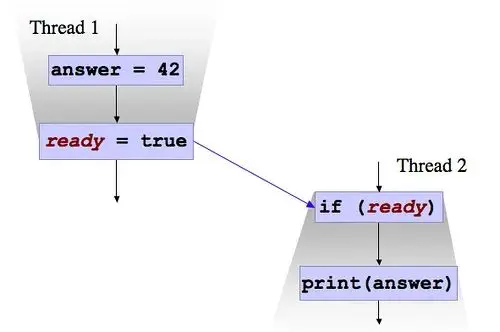字节跳动一面:i++ 是线程安全的吗?
- 简介
- Thread的本地内存
- 例子
- 注意
- 线程同步问题的解决
- 结论
简介
volatile关键字保证了在多线程环境下,被修饰的变量在别修改后会马上同步到主存,这样该线程对这个变量的修改就是对所有其他线程可见的,其他线程能够马上读到这个修改后值.
Thread的本地内存
- 每个Thread都拥有自己的线程存储空间
- Thread何时同步本地存储空间的数据到主存是不确定的
例子

借用Google JEREMY MANSON 的解释,上图表示两个线程并发执行,而且代码顺序上为Thread1->Thread2
1、不用 volatile
假如ready字段不使用volatile,那么Thread 1对ready做出的修改对于Thread2来说未必是可见的,是否可见是不确定的.假如此时thread1 ready泄露了(leak through)了,那么Thread 2可以看见ready为true,但是有可能answer的改变并没有泄露,则thread2有可能会输出 0 (answer=42对thread2并不可见)
2、使用 volatile
使用volatile以后,做了如下事情
- 每次修改volatile变量都会同步到主存中
- 每次读取volatile变量的值都强制从主存读取最新的值(强制JVM不可优化volatile变量,如JVM优化后变量读取会使用cpu缓存而不从主存中读取)
- 线程 A 中写入 volatile 变量之前可见的变量, 在线程 B 中读取该 volatile 变量以后, 线程 B 对其他在 A 中的可见变量也可见. 换句话说, 写 volatile 类似于退出同步块, 而读取 volatile 类似于进入同步块
所以如果使用了volatile,那么Thread2读取到的值为read=>true,answer=>42,当然使用volatile的同时也会增加性能开销
注意
volatile并不能保证非源自性操作的多线程安全问题得到解决,volatile解决的是多线程间共享变量的可见性问题,而例如多线程的i++,++i,依然还是会存在多线程问题,它是无法解决了.如下:使用一个线程i++,另一个i--,最终得到的结果不为0
public class VolatileTest {
private static volatile int count = 0;
private static final int times = Integer.MAX_VALUE;
public static void main(String[] args) {
long curTime = System.nanoTime();
Thread decThread = new DecThread();
decThread.start();
// 使用run()来运行结果为0,原因是单线程执行不会有线程安全问题
// new DecThread().run();
System.out.println("Start thread: " + Thread.currentThread() + " i++");
for (int i = 0; i < times; i++) {
count++;
}
System.out.println("End thread: " + Thread.currentThread() + " i--");
// 等待decThread结束
while (decThread.isAlive());
long duration = System.nanoTime() - curTime;
System.out.println("Result: " + count);
System.out.format("Duration: %.2fsn", duration / 1.0e9);
}
private static class DecThread extends Thread {
@Override
public void run() {
System.out.println("Start thread: " + Thread.currentThread() + " i--");
for (int i = 0; i < times; i++) {
count--;
}
System.out.println("End thread: " + Thread.currentThread() + " i--");
}
}
}
最后输出的结果是
“
Start thread: Thread[main,5,main] i++ Start thread: Thread[Thread-0,5,main] i-- End thread: Thread[main,5,main] i-- End thread: Thread[Thread-0,5,main] i-- Result: -460370604 Duration: 67.37s
原因是i++和++i并非原子操作,我们若查看字节码,会发现
void f1() { i++; }
的字节码如下
void f1();
Code:
0: aload_0
1: dup
2: getfield #2; //Field i:I
5: iconst_1
6: iadd
7: putfield #2; //Field i:I
10: return
可见i++执行了多部操作, 从变量i中读取读取i的值 -> 值+1 -> 将+1后的值写回i中,这样在多线程的时候执行情况就类似如下了
Thread1 Thread2
r1 = i; r3 = i;
r2 = r1 + 1; r4 = r3 + 1;
i = r2; i = r4;
这样会造成的问题就是 r1, r3读到的值都是 0, 最后两个线程都将 1 写入 i, 最后 i 等于 1, 但是却进行了两次自增操作
可知加了volatile和没加volatile都无法解决非原子操作的线程同步问题
线程同步问题的解决
Java提供了java.util.concurrent.atomic 包来提供线程安全的基本类型包装类,例子如下
package com.qunar.atomicinteger;
import java.util.concurrent.atomic.AtomicInteger;
/**
* @author zhenwei.liu created on 2013 13-9-2 下午10:18
* @version $Id$
*/
public class SafeTest {
private static AtomicInteger count = new AtomicInteger(0);
private static final int times = Integer.MAX_VALUE;
public static void main(String[] args) {
long curTime = System.nanoTime();
Thread decThread = new DecThread();
decThread.start();
// 使用run()来运行结果为0,原因是单线程执行不会有线程安全问题
// new DecThread().run();
System.out.println("Start thread: " + Thread.currentThread() + " i++");
for (int i = 0; i < times; i++) {
count.incrementAndGet();
}
// 等待decThread结束
while (decThread.isAlive());
long duration = System.nanoTime() - curTime;
System.out.println("Result: " + count);
System.out.format("Duration: %.2fn", duration / 1.0e9);
}
private static class DecThread extends Thread {
@Override
public void run() {
System.out.println("Start thread: " + Thread.currentThread() + " i--");
for (int i = 0; i < times; i++) {
count.decrementAndGet();
}
System.out.println("End thread: " + Thread.currentThread() + " i--");
}
}
}
输出
“
Start thread: Thread[main,5,main] i++ Start thread: Thread[Thread-0,5,main] i-- End thread: Thread[Thread-0,5,main] i-- Result: 0 Duration: 105.15
结论
- volatile解决了线程间共享变量的可见性问题
- 使用volatile会增加性能开销
- volatile并不能解决线程同步问题
- 解决i++或者++i这样的线程同步问题需要使用synchronized或者AtomicXX系列的包装类,同时也会增加性能开销
网站声明:如果转载,请联系本站管理员。否则一切后果自行承担。
- 上周热门
- 银河麒麟添加网络打印机时,出现“client-error-not-possible”错误提示 1486
- 银河麒麟打印带有图像的文档时出错 1404
- 银河麒麟添加打印机时,出现“server-error-internal-error” 1193
- 统信操作系统各版本介绍 1115
- 统信桌面专业版【如何查询系统安装时间】 1113
- 统信桌面专业版【全盘安装UOS系统】介绍 1067
- 麒麟系统也能完整体验微信啦! 1026
- 统信【启动盘制作工具】使用介绍 671
- 统信桌面专业版【一个U盘做多个系统启动盘】的方法 615
- 信刻全自动档案蓝光光盘检测一体机 526
- 本周热议
- 我的信创开放社区兼职赚钱历程 40
- 今天你签到了吗? 27
- 信创开放社区邀请他人注册的具体步骤如下 15
- 如何玩转信创开放社区—从小白进阶到专家 15
- 方德桌面操作系统 14
- 我有15积分有什么用? 13
- 用抖音玩法闯信创开放社区——用平台宣传企业产品服务 13
- 如何让你先人一步获得悬赏问题信息?(创作者必看) 12
- 2024中国信创产业发展大会暨中国信息科技创新与应用博览会 9
- 中央国家机关政府采购中心:应当将CPU、操作系统符合安全可靠测评要求纳入采购需求 8

